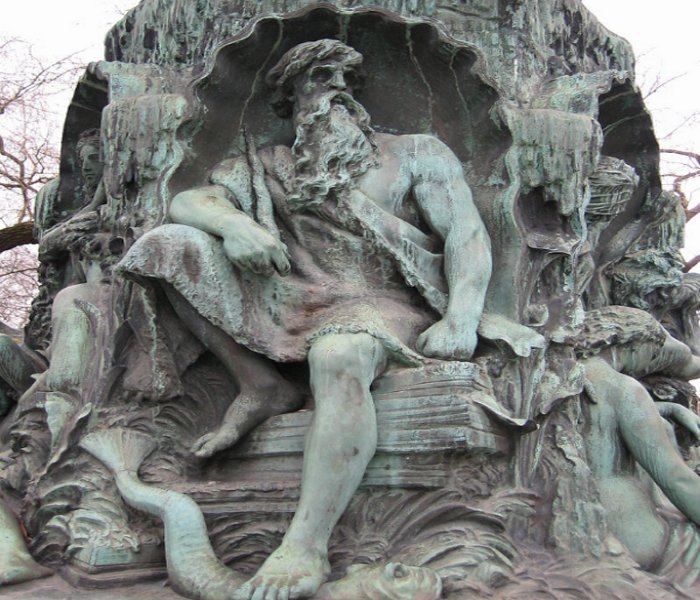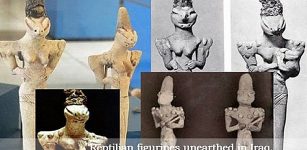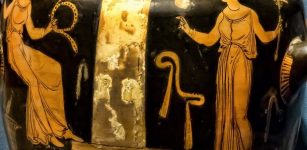Aegir – Jotun Lord Of The Stormy Seas Revered And Feared By Norsemen
A. Sutherland - AncientPages.com - In Norse mythology, Aegir (Ægir) was the ancient jotun lord of the sea, who belonged to a primeval order of gods, predating the Aesir, the Vanir, two different races of Norse gods.
“Aegir and Ran.” Aegir sits and rests his arm on a stone, while his wife Ran pulls on a rope connected to an anchor. Mermaids lounge in the background. Friedrich Wilhelm Heine (1845-1921) after an original by Friedrich Wilhelm Engelhard (1813-1902). Source
Fathered by the great giant Ymir, Aegir was considered omnipotent within his realm. He was the one who existed before them, and he would survive long after they died.
Aegir was usually portrayed as an older man with long white hair and clawlike hands. He lived in a great hall in coral caves beneath the island of Hlesey, (probably the island of Laeso ("Isle of Hlér" "Island of Hlér,") which is the largest island in the North Sea bay of Kattegat, Denmark.
He was a personification of the ocean, often compared to the 'greedy destroyer' in the poetry of seamen and sailors.
In legends of the Anglo-Saxon people, the sea god Aegir was known as 'Eagor.' He was known as Hler ('the shelterer') among the Northern nations and Gymir ('the concealer'). He was a good friend of the Aesir gods, and according to legend, Aegir and Ran organized exquisite underwater banquets for drowned men and gods in the depths of the sea.
However, it was not always so.
 Fountain of JP Molin at Kungsträdgården in Stockholm, 1866. Image credit: Hedning - CC BY-SA 3.0
Fountain of JP Molin at Kungsträdgården in Stockholm, 1866. Image credit: Hedning - CC BY-SA 3.0
"At first, he was no friend of the Aesir. Thor, however, intimidating him with piercing eyes, constrained him to give a banquet for the gods each winter in his own hall; later, he, in turn, paid visits to the Aesir, who received him in a friendly manner. His banquets were in very truth merrymakings, at which ale flowed of its own accord; his hall was lighted by gleaming gold instead of candles; his brisk serving men, Eldir and Fimafeng, ministered to the guests…" 1
In his 'Skáldskaparmál' (or 'language of poetry'), the second part of the Younger Edda, Snorri Sturluson says that Aegir lived with his sister-wife, Ran. The couple had two servants, Eldir and Fimafeng, and nine beautiful giantess daughters (the Wave Maidens) who wore veils and white robes.
The nine daughters of Aegir were his foster mothers. Number nine was of great importance for ancient cultures and their beliefs. It was Odin who mated with them simultaneously to produce Heimdallr, who guarded Asgard and illuminated the world.
There were nine muses, and Hydra, the mythological monster, had nine heads. During the Han Dynasty, cosmology was based on the number nine for a time prevalent Sheol - "nine sources" - The Abode of the Dead. It was believed that Nine Unknown Men were guardians of forbidden knowledge hidden from humanity. In Chinese beliefs, Phoenix was the nine-headed bird ("Jiu Feng"), a monster in Chinese mythology.
There was a time when the Vikings, the masters of the sea, believed in Njord, Aegir, and his wife, Ran. Njord was responsible for the sea near the shore, the wind off the sea, fishing, and trade. His duty was also to calm down dangerous storms created far out at sea by Aegir.
Aegir was revered and feared by sailors experiencing furious storms on the sea. They believed that Aegir – usually angry and hostile - would occasionally appear suddenly to take ships, boats, men, and cargo with him to his underwater domain at the bottom of the ocean. His sisted-wife Ran was even more dangerous.
In Norse mythology, she was known for her presence behind the ice masses, always prepared to act. Using a net, she would capture sailors from their ships and drag them beneath the ocean's waves. There, she reigned alongside her husband, Aegir.
Ran was considered the goddess associated with death for those lost at sea. According to one legend, sailors who perished might reappear at their funeral feasts. Ran was especially inclined to offer them hospitality in her halls if they carried gold overboard. She had a fondness for gold.
Even if they were not her favorites, she wasn't unfriendly. As at Odin's Valhalla, the mead was served at will in the halls of the goddess Ran.
Aegir was a divine ruler of the sea. Ancient people associated with the sea depended on him and his terrible mood. Their faith in Aegir was based on fear; the crews of merchant and fishing boats usually had to navigate far from the shore and home.
They needed a safe journey across the sea; nobody had to remind them that they should always plead to Aegir.
Written by - A. Sutherland - AncientPages.com Senior Staff Writer
Updated on July 6, 2024
Copyright © AncientPages.com All rights reserved. This material may not be published, broadcast, rewritten or redistributed in whole or part without the express written permission of AncientPages.com
Expand for referencesReferences:
H. R. Ellis Davidson in 'Gods and Myths of Northern Europe'
Guerber H. A. Myths of the Norsemen: From the Eddas and Sagas
More From Ancient Pages
-
 Rare Ancient Caribbean Skull Shows Evidence Of Leprosy
Archaeology | Nov 29, 2021
Rare Ancient Caribbean Skull Shows Evidence Of Leprosy
Archaeology | Nov 29, 2021 -
 Advanced Flying Machines And Interplanetary Travel Described 7000 Years Ago In India
Civilizations | Aug 20, 2015
Advanced Flying Machines And Interplanetary Travel Described 7000 Years Ago In India
Civilizations | Aug 20, 2015 -
 Surprising Discovery Of A Perfectly Ancient Road Shows Romans Moved Deeper Into Wales Than Previously Thought
Archaeology | Jul 2, 2022
Surprising Discovery Of A Perfectly Ancient Road Shows Romans Moved Deeper Into Wales Than Previously Thought
Archaeology | Jul 2, 2022 -
 Skull Discovered In Ancient City Of Euromus Shows Neurosurgery Performed 2,200 Years Ago
Archaeology | Aug 2, 2019
Skull Discovered In Ancient City Of Euromus Shows Neurosurgery Performed 2,200 Years Ago
Archaeology | Aug 2, 2019 -
 The Iron Man In The Kottenforst And Other Puzzling Ancient Artifacts Of Unknown Origin And Purpose
Ancient Mysteries | Mar 10, 2014
The Iron Man In The Kottenforst And Other Puzzling Ancient Artifacts Of Unknown Origin And Purpose
Ancient Mysteries | Mar 10, 2014 -
 Yule Goat Is A Scandinavian Christmas Tradition Based On Norse Legends And Worship Of God Thor
Christmas Traditions | Dec 2, 2024
Yule Goat Is A Scandinavian Christmas Tradition Based On Norse Legends And Worship Of God Thor
Christmas Traditions | Dec 2, 2024 -
 The Mystery Of The Serpent Seed
Biblical Mysteries | Jul 19, 2019
The Mystery Of The Serpent Seed
Biblical Mysteries | Jul 19, 2019 -
 The Egyptian Dream Book Reveals Ancient Predictions Of The Future
Egyptian Mythology | Jun 6, 2020
The Egyptian Dream Book Reveals Ancient Predictions Of The Future
Egyptian Mythology | Jun 6, 2020 -
 Hundreds Of Exceptional Bronze Age Artifacts Discovered In France Were Probably Offerings
Archaeology | Aug 28, 2021
Hundreds Of Exceptional Bronze Age Artifacts Discovered In France Were Probably Offerings
Archaeology | Aug 28, 2021 -
 Apulian Secrets: Ancient Burial Rituals Shed Light On A Culture That Left No Written History
Archaeology | Jan 12, 2016
Apulian Secrets: Ancient Burial Rituals Shed Light On A Culture That Left No Written History
Archaeology | Jan 12, 2016 -
 Secrets Of Egyptian Blue – World’s Oldest Artificial Pigment And Its Extraordinary Properties
Featured Stories | May 10, 2021
Secrets Of Egyptian Blue – World’s Oldest Artificial Pigment And Its Extraordinary Properties
Featured Stories | May 10, 2021 -
 Remarkable And Unexplained Historical Sighting Reported By Multiple Witnesses In Wyoming
Featured Stories | Sep 26, 2024
Remarkable And Unexplained Historical Sighting Reported By Multiple Witnesses In Wyoming
Featured Stories | Sep 26, 2024 -
 Mystery Of Great Wall Of California: An Ancient Unsolved Enigma
Civilizations | Sep 11, 2018
Mystery Of Great Wall Of California: An Ancient Unsolved Enigma
Civilizations | Sep 11, 2018 -
 Exceptional Discovery Of Ancient Fresco Depicting Mythological Scenes In Peru
Archaeology | Dec 1, 2022
Exceptional Discovery Of Ancient Fresco Depicting Mythological Scenes In Peru
Archaeology | Dec 1, 2022 -
 It’s Possible To Find Your Ancient Doppelganger – This Is What You Need To Do
Archaeology | Apr 26, 2017
It’s Possible To Find Your Ancient Doppelganger – This Is What You Need To Do
Archaeology | Apr 26, 2017 -
 Location Of Elusive Spanish Fort Is Now Verified By Florida And Georgia Archaeologists
Archaeology | Apr 24, 2020
Location Of Elusive Spanish Fort Is Now Verified By Florida And Georgia Archaeologists
Archaeology | Apr 24, 2020 -
 Ancient Burial Of Woman Equipped With A Unique Gold Pectoral Ornament Discovered In Siberian ‘Valley Of The Kings’
Archaeology | Feb 15, 2022
Ancient Burial Of Woman Equipped With A Unique Gold Pectoral Ornament Discovered In Siberian ‘Valley Of The Kings’
Archaeology | Feb 15, 2022 -
 Evidence Of Stone Age Ear and Lip Piercing Found At Boncuklu Tarla Neolithic Site In Türkiye
Archaeology | Mar 14, 2024
Evidence Of Stone Age Ear and Lip Piercing Found At Boncuklu Tarla Neolithic Site In Türkiye
Archaeology | Mar 14, 2024 -
 800-Year-Old Shipwreck Discovered Off Salento Coast, Italy
Archaeology | Dec 30, 2015
800-Year-Old Shipwreck Discovered Off Salento Coast, Italy
Archaeology | Dec 30, 2015 -
 Mysterious Megalithic Stones Of Carnac, France – An Unsolved Neolithic Enigma
Civilizations | Oct 12, 2018
Mysterious Megalithic Stones Of Carnac, France – An Unsolved Neolithic Enigma
Civilizations | Oct 12, 2018

